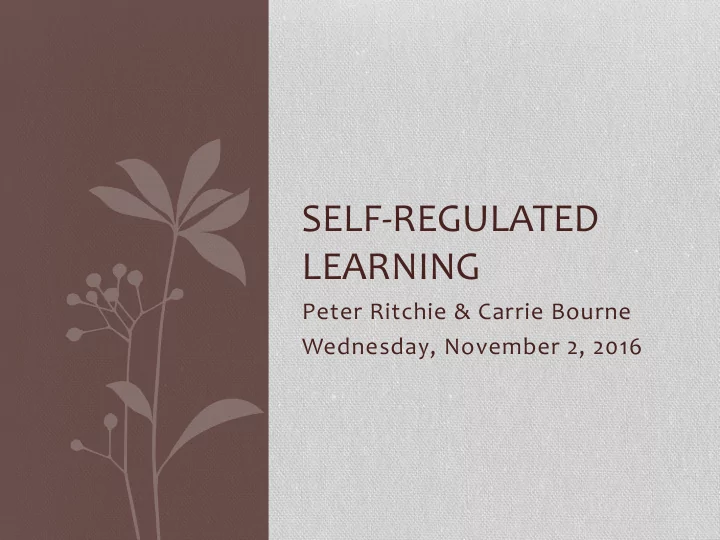

SELF-REGULATED LEARNING Peter Ritchie & Carrie Bourne Wednesday, November 2, 2016
VIDEO
Self-Regulation • Self- regulation refers to individuals’ ability to control thoughts and actions to achieve personal goals and respond to environmental demands (Zimmerman, 2008) • Children who are productively self-regulating attend to key features of the environment and can inhibit automatic or more favoured responses that may not serve them well in particular situations (Blair & Razza, 2007; Ponitz, McClelland, Matthews, & Morris, 2009) • Self-regulation supports both independent and social forms of learning (Zimmerman, 2008; Zimmerman & Schunk, 2011)
Self-Regulated Learning • Self-regulated learning involves metacognition, motivation, and strategic action (Winne & Perry, 2000; Zimmerman, 1990, 2008) • Self-regulated learners exercise metacognition by reflecting on their strengths and weaknesses relative to the demands of tasks they are assigned and, where gaps exist, considering strategies that can be used to ensure their ultimate success • Belinda: my understanding of this article was that SRL is about how classroom teachers can design tasks that encourage students to develop their metacognition, motivation and strategic action while learning and less about the biological, emotional, cognitive, social and prosocial stresses that are key components of SR.
Why is it important? • Self-regulation is recognized as a significant source of achievement differences among students and strategies that promote self- regulation have proven effective for improving achievement in students who struggle academically, including students with exceptional learning needs, such as learning and development disabilities (Graham & Harris, 2003; Wong, Harris, Graham, & Butler, 2003; Zimmerman & Schunk, 2011)
SRL Diagram
SR Diagram
Connecting SRL to SR
Co-regulation • Co-regulation involves giving and receiving support that is instrumental to learning and SRL • It presumes at least one participant in an interaction has knowledge or skills that others need to achieve a goal • Co-regulators can be adults for children or children for peers • Children can also co-regulate adults • Requires socially responsible self-regulation
Co-regulation • Co-regulators provide students with just enough and just-in-time support for developing and enacting self-regulation ( Vygotsky ) • They scaffold, establish familiar participation structures, enable students to support one another, and engage in non-threatening evaluation practices • Classroom discourse is the vehicle for providing these supports (eg. Class meetings, mini-lessons, informal interactions with students)
Task Understanding • Explicit task understanding refers to learners’ grasp of the task requirements, criteria for evaluation, and available materials • Implicit task understanding refers to information that learners must infer from the more explicit elements of a task, task context, or their experience with similar tasks (learner’s awareness of task’s purpose, relevant ideas and concepts, and strategies for completing it • Contextual task understanding refers to learners’ knowledge of how the task relates to larger ideas and intentions
Autonomy promoting practices • Teachers who support autonomy are responsive to students’ needs and interests and want students to be active rather than passive in learning • They rarely offer solutions or use directives when interacting with students • Privilege students’ perspectives and encourage student initiative • Students in autonomy supporting classrooms choose moderately difficult tasks, strive for deep understanding, persist through challenges, and experience high levels of perceived confidence and enjoyment during learning, as well as positive academic outcomes • 3 important provisos • Student choice • Awareness of individual student needs (low floor, high ceiling/entry points) • Learners personalized interpretations of opportunities to regulate learning (all, some, few)
Activity • Read reflections • Refer back to Perry’s article • Sort reflections into categories • Give a title to each category • Discuss examples from your own classrooms that would fit into the categories (be prepared to share at least one example from one category)
Share • Titles of categories • One example from one category • Did you face any challenges when assigning reflections to certain categories?
CLASSROOM EXAMPLE
Learning Intentions • I can communicate my mathematical thinking in many ways • I can explain and justify mathematical ideas and decisions (“prove it!”) • I can be kind to others, can work or play co-operatively, and can build relationships with people of my choosing
WODB www.wodb.ca
Feedback Frame • Cherie: BC’s refreshed curriculum has moved to a more individualized and personalized approach. It will be interesting to see how children will self-evaluate for their own regulation.
How does this activity address self-regulated learning according to Perry? • Task understanding-learning intentions • Low floor, high ceiling (entry points) • Choice for how students interpret numbers • Co-regulation (adult to peer, peer to peer, peer to adult) • Familiar participation structure (routine) • Non-threatening evaluation practice (feedback frame)
BC Curriculum • Davinder: The new BC curriculum has thrown many educators into a dizzy spin as they have “educated” students in the same way for many years and now this new framework has introduced challenges and difficulties in changing and “facilitating” knowledge and tasks within the 21st century classrooms. Self-regulated learning and the new curriculum seem to tie well together as the curriculum aims for a learner-centered approach and SRL aims for student control. • Robyn: “children have opportunities to self -regulate learning in classrooms where they are engaged in complex meaningful tasks and where student autonomy, including choice, control over challenge, and opportunities to self-evaluate learning, is promoted and supported through highly effective forms of co- regulation” (pg. 50). I feel like this statement is also inline with the revised BC curriculum which promotes interdisciplinary units of inquiry. Another example of this are the core competencies. Students are encouraged to engage in self-reflective learning at every opportunity.
RESOURCES • BCTF- https://bctf.ca/publications/NewsmagArticle.aspx?id=29340 • SRL Canada- http://srlcanada.ca/
Recommend
More recommend